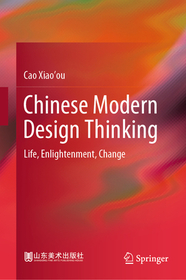
Chinese Modern Design Thinking
Life, Enlightenment, Change
- Publisher's listprice EUR 53.49
-
22 184 Ft (21 128 Ft + 5% VAT)
The price is estimated because at the time of ordering we do not know what conversion rates will apply to HUF / product currency when the book arrives. In case HUF is weaker, the price increases slightly, in case HUF is stronger, the price goes lower slightly.
- Discount 20% (cc. 4 437 Ft off)
- Discounted price 17 748 Ft (16 902 Ft + 5% VAT)
Discounted price for customers subscribed to our weekly newsletter.
Subcribe now and take benefit of a favourable price.
Subscribe
Subcribe now and take benefit of a favourable price.
Subscribe
22 184 Ft

Availability
printed on demand
Why don't you give exact delivery time?
Delivery time is estimated on our previous experiences. We give estimations only, because we order from outside Hungary, and the delivery time mainly depends on how quickly the publisher supplies the book. Faster or slower deliveries both happen, but we do our best to supply as quickly as possible.
Product details:
- Edition number 1st ed. 2024
- Publisher Shandong Art Publishing House
- Date of Publication 30 October 2024
- Number of Volumes 1 pieces, Book
- ISBN 9789819998982
- Binding Hardback
- No. of pages307 pages
- Size 235x155 mm
- Language English
- Illustrations XVI, 307 p. 254 illus., 217 illus. in color. Illustrations, black & white 608
Categories
Arts in general
Art history in general
Second half of 20th century and 21st century
Art history books published in German
Design in general
Arts in general (charity campaign)
Art history in general (charity campaign)
Second half of 20th century and 21st century (charity campaign)
Art history books published in German (charity campaign)
Design in general (charity campaign)
Long description:
This book studies the development of modern and contemporary design art in China since 1978. Starting with the design enlightenment, and closely following the evolution of the visual and material forms in three levels of “individual”, “group”, and “country” since the reform and opening up, the book comprehensively and meticulously describes and analyzes the social particularity of the changes of Chinese design art in this period and makes corresponding evaluations on its “success” and “failure”. The author believes that Chinese modern design thinking has arisen from the problems displayed in the phenomena and events of Chinese modern design. Therefore, with nine chapters organized in chronological order and unfolded layer by layer by focusing on the relevant topics of “design thinking”, the book has sorted out the academic contentions, important events, phenomena, details of Chinese design in this period by placing design in the background of great history, and has searched, discovered, and summarized the key problems of Chinese design in each stage, and analyzed the causes and consequences, and has specially studied on the gains and losses of important phenomena and theoretical problems and correspondingly made theoretical comments. Therefore, it is a book comprehensively presenting the overall look of the development of Chinese modern design “thinking” history.
This book has a grand structure and detailed content. The author and her research objects always coexist in the same context, and the writing style is fresh, the argument is reasonable, and the pictures and texts complement each other, so the book has both academic depth and readability.
More
Table of Contents:
Preface I.- Preface II.- Chapter 1 Design and Modern Enlightenment.- Chapter 2 “Revolution” and “Technological Aesthetics”.- Chapter 3 The Beginning of “Contemporaneity” and The End of “Arts and Crafts”.- Chapter 4 Design in the “New Era”.- Chapter 5 Paradox of “Manufacturing”.- Chapter 6 Imagination of Urbanization.- Chapter 7 The National Design Strategies.- Chapter 8 Discourse Mode of Design.- Chapter 9 Design in the Era of Globalization.- Postscript.
More
Recently viewed










